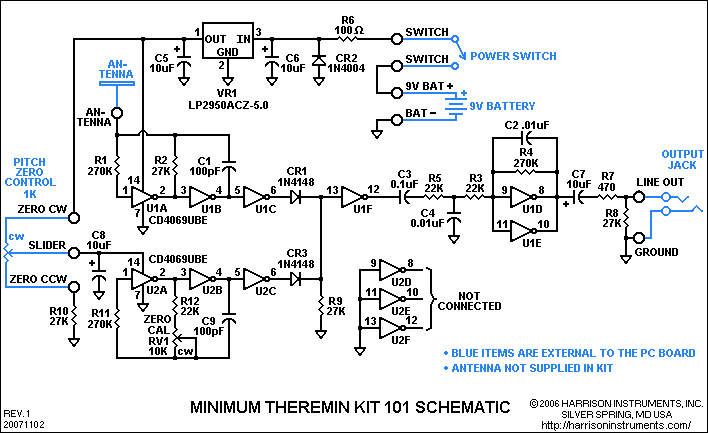
Minimum Theremin Circuit Description
Minimum Theremin Kit 101 Schematic
(Back to "Technical Information")

Minimum Theremin Circuit Description
Two identical integrated circuits, U1 and U2, known as "hex inverters" are used for the theremin's primary functions. They are CMOS (Complimentary Symmetry Metal Oxide Semiconductor) devices, typically used in digital circuits to perform a logic function called "inversion." Each IC contains six identical sections; thus the term "hex inverter."
U1 sections A and B, in conjunction with R1, R2 and C1, form the theremin's variable oscillator that operates in a frequency range around 73kHz. The antenna forms one-half of a variable capacitor that is part of this oscillator's frequency-determining network, and the player's hand forms the other half. As the distance between the hand and the antenna varies, so does the capacitance, and therefore the oscillator's frequency. U1 section C buffers the variable oscillator's output to provide isolation from the rest of the circuit.
U2 sections A and B, in conjunction with R11, R12, RV1, and C9, comprise the theremin's local oscillator, adjusted with the PITCH ZERO CONTROL potentiometer and ZERO CAL potentiometer RV1. RV1 is a miniature "trimmer" type, mounted on the circuit board, used to calibrate the local oscillator's frequency range. With RV1 properly adjusted, the local oscillator's frequency will equal the variable oscillator's frequency with the hand furthest away from the antenna. Under these conditions, the phase relationship of the two oscillators will be constant due to their small, but finite capacitive coupling, so no audible tone will be produced. U2 section C buffers the local oscillator's output to provide isolation from the rest of the circuit. The three remaining U2 sections are not used, so their inputs are grounded.
The inverters' propagation delays and output impedances are supply-dependent. Accordingly, the PITCH ZERO CONTROL potentiometer affects the local oscillator's frequency by varying its supply voltage. This method of adjustment permits the potentiometer to be located at any convenient distance from the circuit and antenna, since frequency variations resulting from stray capacitance between the potentiometer's slider and ground are decoupled by capacitor C8. In use, the potentiometer is adjusted by the player so that the theremin is silent with the hand furthest away from the antenna, and produces the lowest tone when the hand is at the maximum playing distance.
Diodes CR1 and CR3, and resistor R9 comprise a logic "OR" gate which is the theremin's mixer. The mixer "heterodynes" the two oscillator signals, producing sum and difference terms of their fundamental frequencies and harmonics. U1 section F buffers the mixer's output. C3 is a DC blocking capacitor that couples the mixed signal to a low-pass filter consisting of R5 and C4. This filter reduces the inaudible heterodyne sum products, leaving the audible difference, or "beat frequency" product. The beat frequency signal is applied to an amplifier comprised of U1 sections D and E, and gain-determining resistors R3 and R4. Capacitor C2 provides a second low-pass filtering section to further attenuate the inaudible heterodyne products. DC is blocked from the output by C7, with R7 limiting the output current to prevent damage to U1 and R8 preventing C7 from maintaining a residual charge.
Because the theremin's oscillators have some sensitivity to power supply variations, VR1, a low-dropout voltage regulator IC, with C5 and C6, is used to furnish a steady 5 volts. Rectifier CR2 protects the circuit from accidental battery reversal, and R6 prevents excessive current from causing CR2 and the battery to heat under such a condition. The voltage drop across R6 is less than 200 millivolts, causing a relatively insignificant loss in battery life. The theremin typically uses less than 2 milliamperes of current, so a 9 volt alkaline battery will provide many days of operation. The instrument will operate with a battery as low as 5.5 volts.
The inherently low "Q" characteristic of the oscillators establish a limit for the lower audible frequency, below which, electromagnetic interference from power lines and appliances, combined with stray-capacitive coupling between the oscillators, compromise the output fidelity. This effect diminishes if the instrument is far from interfering sources.
The Minimum Theremin may be connected to an amplifier via the OUTPUT JACK. The theremin also has sufficient output current to drive efficient, high-fidelity headphones. For use with stereo headphones, the user may wish to replace the jack with a stereo type that has its "tip" and "ring" contacts connected together, or simply use a suitable adapter. CAUTION: Use headphones that have a built-in volume control, and adjust the volume control for a comfortable level. Hearing experts advise against the continuous, extended use of headphones.
For a theremin to operate properly, sufficient capacitive coupling must exist between the player's body and the instrument. Although not obvious, a player is sufficiently "coupled" to earth via his or her surface area, which presents a large capacitance to earth's ground through "free space." When the theremin is connected to an amplifier, it too, is grounded via an electrical connection and/or capacitance between the amplifier circuitry and earth. This "free space" coupling, along with the amplifier's connection to ground, provide the desired common connection between the player's body and the instrument.
When used with headphones, and not connected to external equipment, there may not be sufficient capacitive coupling between the instrument and player. This may be remedied by connecting the circuit's ground (battery negative terminal) to earth or a nearby metal object. A metal microphone stand, if used to mount the theremin, is suitable for this purpose. If this is not practical, grasping a few coils the headphone cord will provide sufficient coupling between the player and the circuit's ground.
Temperature performance is excellent for this theremin; warm-up drift is
negligible due to the conservative power levels in the oscillator ICs, as
well as first-order drift cancellation between the oscillators' similar
configurations.
(top)